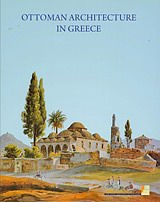
Ottoman Architecture in Greece
Τύπος: ΒιβλίοΣυγγραφέας: Συλλογικό έργο,
Μεταφραστής: Fowden, Elizabeth Key
Επιμελητής: Μπρούσκαρη, Έρση
Εκδόσεις: Υπουργείο Πολιτισμού
- Χρονολογία Έκδοσης: 2008
- Σελίδες: 494
- ISBN-13: 978-960-214-793-1
- Διαθεσιμότητα: **Αποστέλλεται κατόπιν παραγγελίας σε 2-4 ημέρες και εφόσον υπάρχει στον εκδότη
αρχική τιμή:
[...] The catalogue that follows is not exhaustive, but it does aim to be representative: it treats all types of buildings in all the areas of Greece where such monuments appear. Also, in order to enable the reader to acquire a complete overview of the architecture of this period, a point has been made of including not only buildings which are unquestionably Ottoman in their function and architecture, such as mosques, imarets, hamams, tekkes etc., but also citadels, bridges or dwellings which were in use by all sections of the population.
Ίhe book is divided into three parts. Part 1 consists of three introductory chapters, the first of which provides a general account of the Ottoman Empire and the Greek lands more specifically, while the second and third discuss the characteristics of Ottoman architecture in Greece. For readers' convenience, Ottoman architecture is divided into secular and religious categοries, though this is no more than a convention, since the boundary between religious and secular architecture is hard to draw. Supposedly "secular" buildings such as bath houses are often part of larger religious-philanthropic-educational complexes.
The chapters on Ottoman architecture serve as an introduction to Part 2, the heart of the book, where the monuments are described region by region. In many cases the regional sections are prefaced by a historical introduction to the main town and its growth under Ottoman rule. An invaluable source for this survey is provided by the 17th century Ottoman traveler Evliya Celebi, who left precious descriptions of many towns and their monuments. Evliya's account' is often exaggerated or inaccurate, but still a rich source of information, which in conjunction will, other sources (historical, archival, archaeological and so forth) helps us to identify and date our monuments.
Αn effort has been made to standardize the descriptions of monuments and to make them as thorough as possible. Each entry contains an account of the monument's history (where that is possible), its dating and its architectural form, including the main phases of repair and restoration. Reference is also made to the new uses to which a number of buildings have been put, in order to give them a role in the country's contemporary cultural life.
The book closes with a time chart, a glossary of (mainly) architectural terms used in the text and which may confuse the non-specialist, and finally, a bibliography. [...]
(from the Introduction, Ersi Brouskari)
| ISBN13: | 978-960-214-793-1 |
| Πρωτότυπος Τίτλος: | Η οθωμανική αρχιτεκτονική στην Ελλάδα |
| Συγγραφέας: | Συλλογικό έργο |
| Εκδότης: | Υπουργείο Πολιτισμού |
| Χρονολογία Έκδοσης: | 2008 |
| Σελίδες: | 494 |
| Εξώφυλλο: | Πανόδετο |
| Σχήμα: | 31χ24 |
| Διαθεσιμότητα: | Κυκλοφορεί |
| Βάρος: | 3044 γραμμάρια |
| Είδος: | Βιβλίο |
| Αρχική Γλώσσα: | ελληνικά |






















